The Next Generation
A look at the100E and
300E Series Ford Anglia, Prefect, Squire and Thames
By Dean Kirsten
In October of 1953, Ford at Dagenham, England, announced thefirst
of what was hoped to be tens of thousands of new vehiclesfeaturing
the Anglia, Prefect, Squire and Thames name plates.For the first
time since the end of World War II, Ford had completelyretooled
their factory to bring their fleet up to date with therest of
the automotive world. What would be considered a 1954model, the
new version of the famed Anglia and Prefect would nowbe constructed
in a whole new way, using the unibody design. Longgone was a body
lowered onto a stamped chassis then riveted andwelded together.
Ford was now building a much stronger and moremodern car and van,
that offered a MacPherson front suspension,leaf spring rear suspension
and a solid roof design. Long-gonewas the fabric top that was
created solely to simplify the constructionof the body. I know
some of you thought it was done to createan open top sunroof,
but that was not the case. These new Fordwould carry the model
numbers 100E for the passenger vehicles,and 300E for the vans
and Squire.
Believe it or not, the wheelbase of the 100E/300Es was actuallyshorter
than the earlier models; 87-inches compared to 90-inches,which
seems strange today. Even the engine, transmission and rearends
were changed, although the engine size remained the same1172cc,
but contained numerous changes inside and out. Horsepowerwas posted
at 36hp, which was considered to be "Lively atthat time".
When new, these cars went for about $1500, andwere sold by selected
Ford dealers across the country.
Unlike the early Thames panel, the newer 300E still featured
wood floors, but framing was now all steel, which finally got
away from using woodto hold the backend together. During the five
years of productionof this (new) model, about the only changes
made to the exteriorwas the grille design, and rear taillight
assemblies.
The beauty of this new model design was that both the 2-doorAnglia
and the 4-door Prefect used the same basic body platform,other
than the side panels that contained the doorframes. Thereis a
fun tale that has been tossed around for decades that oneday,
during the 1954 production, a passenger vehicle came offthe assembly
line with an Anglia left panel, and a Prefect rightpanel. In other
words, it had one door on the left and two doorson the right!
I don't know what actually happened to his 3-door"Angfect",
but it's funny to think about what couldhave happen at the factory.
|
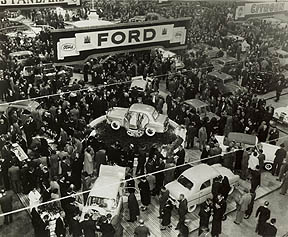
Paris auto show, October 1953 was the big debut of the new
Ford Anglia. You can see the 1954 Ford Popular on the far left,
which was introduced at the same show as a low cost alternative
to more modern cars.
|
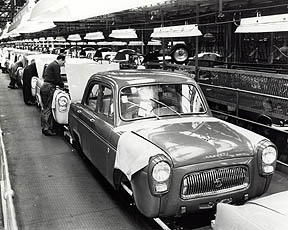
Assembly line at Dagenham shows both the Prefect and Anglia
were built side-by-side, on the same line.
|
|
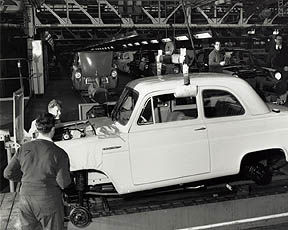
Another view of the 100E assembly line shows an Anglia in
the final stages of assembly.
|
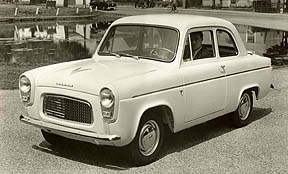
Factory photo of a 1958 Anglia Deluxe 2-door sedan. Its styling
was described as "perky", which is not what I would
call it, would you? This one is a left-hand drive model headed
for the North American market.
|
|
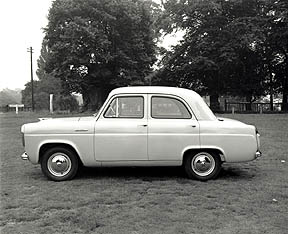
Side view of the 1954 model 100E Prefect 4-door. Pretty basic
trim, or lack of..
|
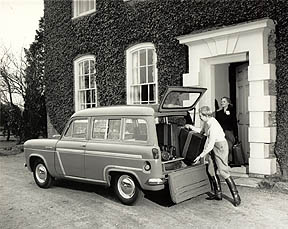
The Ford Squire was a woodie of sorts. Yes, there were a few
strips of real wood mounted here and there, but not exactly what
we would consider the real deal.
|
|
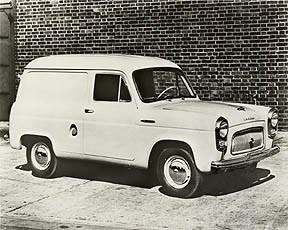
A 1957 Thames panel with chrome headlight trim was ready for
the North American market. Make a nice gasser today.
|
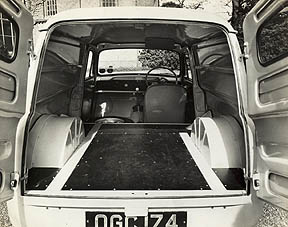
Inside the 300E Thames panel looks like it is ready for huge
tires, based on the appearance of the rear wheel tubs, but not
really. Passenger seat was an option.
|